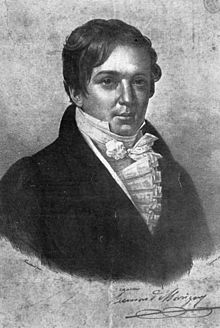Hazard (dice game)

Hazard , old English or French Hasard , is an old English game with two dice , which was mentioned in the 14th century by Geoffrey Chaucer in the Canterbury Tales . The name Hasard is derived from the Arabic yasara for "to throw the dice".
Despite the complicated rules, Hazard was so popular in the 17th and 18th centuries that it became a game of chance . Games of chance are therefore generally considered games of chance called. Hazard was particularly popular at Crockford's, Almack’s and Brooks's Club in London .
Hazard was known early on under the name Craps . Modern craps , which is played privately and in casinos , emerged from Hazard at the beginning of the 19th century by simplifying the original rules (see below).
In addition to the game with two dice, there was also a variant with three dice. The name Grand Hazard for the game with three instead of only two dice now means the game Sic Bo or Chuck a Luck .
The rules

A player, the shooter or caster , places a bet, the banco ; the other players, the faders , bet against it. Once the bets have been placed, the game begins with the determination of the main point . To do this, the shooter rolls two dice until he has a total of 5, 6, 7, 8 or 9 - other throws do not count. The number thus determined is the main point or faders' point .
Now the shooter rolls the dice one more time. In this throw, the decision about profit (caster throws in or nicks ) or loss (caster throws out ) or a chance point , also shooter's point, is determined according to the following table:
| Main point | Shooter wins on throw of | Shooter loses on throw of | Throw of ... provides the chance point |
|---|---|---|---|
| 5 | 5 | 2, 3, 11, 12 | 4, 6, 7, 8, 9, 10 |
| 6th | 6, 12 | 2, 3, 11 | 4, 5, 7, 8, 9, 10 |
| 7th | 7, 11 | 2, 3, 12 | 4, 5, 6, 8, 9, 10 |
| 8th | 8, 12 | 2, 3, 11 | 4, 5, 6, 7, 9, 10 |
| 9 | 9 | 2, 3, 11, 12 | 4, 5, 6, 7, 8, 10 |
If there is no immediate decision in this litter, i. H. if a chance point is determined, the shooter keeps rolling until he either hits the main point and loses or rolls the chance point again and wins.
If the shooter wins, he may keep the dice and continue playing; However, he is then not allowed to take any profits from the bank. If the shooter loses immediately after determining the main point (i.e. because he threw a 2, 3, or an 11 or 12 as the case may be ) in the first throw after the main point has been determined, he may also throw the dice if he wishes keep and place a new banco. The shooter can, however, also pass the dice on to his right neighbor.
If the shooter loses by throwing the main point after determining the chance point, he must pass the dice on to his right-hand neighbor.
The shooter wins with a probability of 49.1%; it is therefore at a disadvantage compared to the faders, the advantage of the faders is approx. 1.8% (see bank advantage ).
In a single game, an average of 5.2 throws are required before a decision can be made about win or loss ( expected playing time).
If you omit the determination of the main point and set this to seven in advance, the game corresponds to the rules of craps; Bernard de Mandeville is said to have introduced this simplification in New Orleans in 1813 .
Side bets
If a chance point is determined in a round, the shooter can usually place further bets ( side bets ) with a so-called setter - at the fair odds.
Assuming the main point is 7 and the chance point is 4, the shooter wins on a roll of 1–3, 2–2, 3–1 and loses on a roll of 1–6, 2–5, 3–4, 4-3, 5-2, 6-1. Since the three combinations that are favorable for the shooter face six unfavorable combinations, the odds are 6: 3 or 2: 1.
The following table generally applies:
| Main point | Chance point | ||||||
|---|---|---|---|---|---|---|---|
| 4th | 5 | 6th | 7th | 8th | 9 | 10 | |
| 5 | 4: 3 | 4: 5 | 2: 3 | 4: 5 | 1: 1 | 4: 3 | |
| 6th | 5: 3 | 5: 4 | 5: 6 | 1: 1 | 5: 4 | 5: 3 | |
| 7th | 2: 1 | 3: 2 | 6: 5 | 6: 5 | 3: 2 | 2: 1 | |
| 8th | 5: 3 | 5: 4 | 1: 1 | 5: 6 | 5: 4 | 5: 3 | |
| 9 | 4: 3 | 1: 1 | 4: 5 | 2: 3 | 4: 5 | 4: 3 | |
These side bets live on in craps in the form of odds bets .
literature
- Hazard . In: Encyclopædia Britannica . 11th edition. tape 13 : Harmony - Hurstmonceaux . London 1910, p. 117 (English, full text [ Wikisource ]).
Web links
Individual evidence
- ↑ Hazard, that . In: duden.de .
- ^ Rouge Et Noir: The Academicians of 1823, Or, The Greeks of the Palais Royal . Here the game with three dice is described (but incompletely) under the name Kraps (sic!). ( limited preview in Google Book search)

